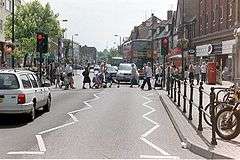High Street
High Street (or the High Street, also High Road) is a metonym for the concept (and frequently the street name) of the primary business street of towns or cities, especially in the United Kingdom and Commonwealth of Nations. To distinguish it from "centres" of nearby places it is frequently preceded unofficially by the name of its settlement. In a town it implies the focal point for business, especially shops and street stalls (if any) in town and city centres. As a generic shorthand presupposed upon linear settlements it may be used to denote more precise concepts such as the urban retail sector, town centre sectors of employment, all small shops and services outlets and even wider concepts taking in social concepts.[lower-alpha 1]
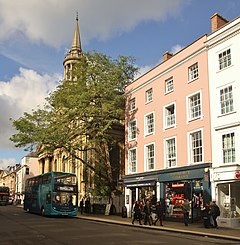
The number of High Streets grew from the 17th century and reached a peak in Victorian Britain. Since the 20th century, the prosperity of High Streets has been in decline, forcing many shop closures and prompting the UK government to consider initiatives to reinvigorate and preserve the High Street.
High Street is the most common street name in the UK, which according to a 2009 statistical compilation has 5,410 High Streets, 3,811 Station Roads and 2,702 Main Streets.[1]
Definition and usage
In Middle English the word "high" denoted a very meaning of excellence or superior rank ("high sheriff", "Lord High Chancellor", "high society"). "High" also applied to roads as they improved: "highway" was a new term taken up by the church and their vestries during the 17th century as a term for all public roads between settlements.[2] From the 19th century, which saw a proliferation in the number of public roads (public highways), in countries using the term motorway, the term highway fell out of common speech and was supplanted by the legal definition, denoting any public road, as in the Highway Code. Thus the term "High Street" assumed a different meaning; that of a street where the most important shops and businesses were located.[3]
In Britain, the term 'High Street' has both a generic and a specific meaning. People refer to shopping on the high street when they mean the main retail precinct, but also refer to shopping on the High Street when they mean a specific street carrying the name of High Street or one of its variants. Many former British colonies, including Canada, Australia and New Zealand, adopted the term to refer to the main retail shopping precinct in a given city or town. In some New England states, especially in Massachusetts, High Street is also used. High Street is also used in the Republic of Ireland but it is less common.
Incidence
In Britain, some 3,000 streets called High Street and about 2,300 streets with variations on the name (such as Upper High Street, High Street West) have been identified, giving a grand total of approximately 5,300.[4] Of these, more than 600 High Streets are located in London's boroughs.[5]
Main Street is a term also used in smaller towns and villages in Scotland. In North East England, the main commercial district is Front Street (especially in cities located alongside a waterway). In Cornwall, some places in Devon and some places in the North of England, the equivalent is Fore Street; in some parts of the UK Market Street is also used, although sometimes this may be a different area where street markets are currently (or were historically) centred.
History
Following the Great Fire of London (1666), the city of London was completely rebuilt. New planning laws, governing rebuilding, designated four types of street based on the size of their carriageways and the types of buildings. Shops were permitted in the principal street or 'high street', but not in the by-lanes or back streets. This may have been based on the need for high visibility in order to regulate retail trade, as well as to avoid congestion in the narrow lanes and back streets.[6] Accordingly, from the 17th-century, the term "High Street" gradually assumed a narrower meaning and came to describe thoroughfares with significant retail in large villages and towns.
In the late 17th and 18th-centuries, the number of High Streets increased markedly. The 19th-century was a "golden era" for High Street shops.[7] The rise of the middle class in Victorian England contributed to a more favourable attitude to shopping and consumption. Shopping centres became the places to see and be seen - places for recreational shopping and promenading.[8] By the 20th century, however, the viability of high streets began to decline.
In the second half of the 20th-century, traditional British High Street precincts came under pressure from out-of-town shopping malls, with the balance shifting towards the latter.[9] In the late 20th-century, bricks and mortar retailers confronted another major threat - from online retailers operating in a global marketplace. To confront this threat, High Street precincts have been forced to evolve - some have become smaller as shops shut their doors, others have become more like social spaces with a concentration of retail services including cafes, restaurants and entertainment venues while yet others have positioned themselves as more up-market shopping precincts with a preponderance of stores selling luxury branded goods.[10]
In the United Kingdom geographic concentration of goods and services (including at industrial estates and out of town shopping centres) has reduced the share of the economy contributed to by workers in the high street. High street refers to only a part of commerce. The town centre in many British towns combines a group of outdoor shopping streets (one or more of which may be pedestrianised), with an adjacent indoor shopping centre.
High Streets through the centuries
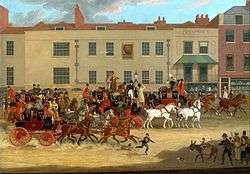 The Peacock Inn, High Street, Islington, c. 1700
The Peacock Inn, High Street, Islington, c. 1700 High Street, Edinburgh in the 18th century
High Street, Edinburgh in the 18th century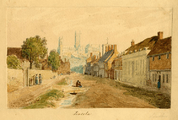 Lincoln High Street, c. 1820
Lincoln High Street, c. 1820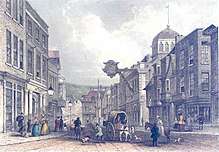 Winchester High Street, 1853
Winchester High Street, 1853 Angel Inn on High Street, 1882
Angel Inn on High Street, 1882.jpg) Houses in High Street, 1888
Houses in High Street, 1888.jpg) Corner of High Street, 1888
Corner of High Street, 1888.jpg) High Street, Belfast, 1888
High Street, Belfast, 1888.jpg) High Street, Dunedin, 1914
High Street, Dunedin, 1914 High Street, Charing, Kent, 1905
High Street, Charing, Kent, 1905 Crawley High Street, 1922
Crawley High Street, 1922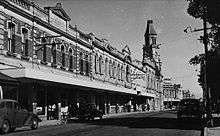 High Street, Fremantle, c. 1940
High Street, Fremantle, c. 1940
Trends
Initiatives to preserve the traditional British High Street are evident. Research into the customer's shopping preferences and patterns reveals that the continued vitality of towns is predicated on a number of different variables. Research has highlighted the ongoing challenges faced by towns and cities and suggested that "[t]he town centre serves not only social, utilitarian or hedonic shopping purposes but also supports out-of-hours entertainment and leisure services. The way that consumers perceive and use town centres has also fundamentally changed."[11] In order to address the issues threatening the sustainability of towns it is increasingly important to consider consumer behaviour and customer experience. This is in line with research that proposes that for high street retail to thrive in spite of the growth threat of eCommerce, the sensual hedonic experiences (e.g. scent, feel, etc.) need to be presented to visitors while allowing for discovery of hidden experiences in the built environment.[12]
Small shop preservationist movement
The House of Commons in 2006 established an All Party Parliamentary Small Shops Group, which published a report titled High Street Britain 2015, warning against trends in high streets that were disadvantageous to small shops.[13] The report warns that the increase in chain stores on high streets contributes to the formation of clone towns, a concept set out by geographical theorists, which "creat[es] a loss of sociability" compared to traditional shopping. Members of the working group generally agreed that: "The demise of the small shop would mean that people will not just be disadvantaged in their role as consumers but also as members of communities – the erosion of small shops is viewed as the erosion of the 'social glue' that binds communities together, entrenching social exclusion in the UK."
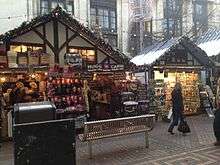
The Portas Review
In 2011, business consultant, Mary Portas, best known for the TV Series, Mary Queen of Shops, was commissioned by the UK government to provide an independent review of High Street shopping.[14] The report provided evidence for the decline of High Street precincts such as data indicating that retail spending in High Street shops had fallen to below 50 per cent.[15] Her final report set out a vision for High Streets and a number of recommendations. However, her plan has failed to stem the number of High Street store closures, leaving authorities in a quandary about how to proceed.[16]
Comparative usage
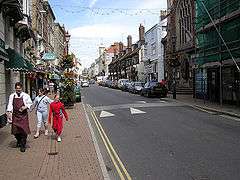
The term "High Street" is used to describe stores found on a typical high street to differentiate them from more specialised, exclusive and expensive outlets (often independent stores) – for example, "High Street banks" (instead of the less-common private or investment banks) or "High Street shops" (instead of boutiques).
The phrase "High Street banks" is used to refer to the retail banking sector in the United Kingdom.[17]
International equivalents
Australia
Alongside High Street, the term Main Street is also used in smaller towns and villages.
Canada
Alongside the term High Street, the term Main Street is also used. In Canada, east of Lake Superior, King Street and Queen Street are often major streets; rue Principale, as the literal French language equivalent of Main Street is frequently used in Quebec towns, and "a village where the main street is still Main Street" is a phrase that is used in respect for small towns. In some sections of Canada, the main commercial district is Front Street (especially in cities located alongside a waterway).
Germany
In Germany, the equivalent is Hauptstraße (Main Street), though this can also refer to a road with a lot of traffic (i.e., a highway). In Cologne the Hohe Straße (literally, High Street) is the main shopping street, but was named after a gate at its southern end (the Hohe Pforte, or High Gate).[18]
Ireland
High Streets are less commonly seen in Ireland. Neither of Dublin's two main shopping streets (Grafton Street and Henry Street) carry this name, nor does its main thoroughfare (O'Connell Street). While Dublin has a High Street near Christchurch, it is not a shopping street.[19] The city of Cork's main shopping street is St Patrick's Street. The city's oldest streets are named North Main Street and South Main Street. Limerick's principal thoroughfare, like Dublin, is also O'Connell Street (the name is used in a number of other Irish towns in honour of Daniel O'Connell).
Main Street is used in many smaller towns and villages. For example, the OSI North Leinster Town Maps book lists sixteen "Main Streets" and only two "High Streets" in its thirty-town index of street names. Similarly, the OSI Dublin Street Guide (covering all of Dublin City and County Dublin) lists twenty "Main Streets" and only two "High Streets". Killarney and Galway are two of the few large Irish towns in which the shopping streets are named High Street.
Jamaica
In Jamaica, the main commercial district is Front Street (especially in cities located alongside a waterway).
The Netherlands
The Dutch equivalent is Dorpsstraat, of which examples are found in cities such as Brussels, Amsterdam, Antwerp, Bruges, Rotterdam and many towns.
United States
The equivalent in the United States is Main Street. In some sections of the United States, the main commercial district is Front Street (especially in cities located alongside a waterway).
See also
Notes
- Expressions include High Street culture and High Street venues or forums.
References
- "Halifax Estate Agents reveals the UK's Top 50 street names" (PDF). Lloydsbankinggroup.com. Retrieved 2 October 2017.
- Douglas Harper (2001–2012). "highway". Online Etymology Dictionary. Douglas Harper. Retrieved 30 July 2012.
- Cambridge Dictionary Online, Online:
- "High Street", BBC History Magazine, [Digital Content], 15 March 2011, Online:
- Vaughan L., "High Street Diversity" in: Laura Vaughan (ed.), Suburban Urbanities: Suburbs and the Life of the High Street, UCL Press, 2015 p. 204
- Cox, N., "'Beggary of the Nation': Moral, Economic and Political Attitudes to the Retail Sector in the Early Modern Period", in: John Benson and Laura Ugolini, A Nation of Shopkeepers: Five Centuries of British Retailing, London, I.B. Taurus, 2003, p. 38
- Lane, M., "When was the High Street at its best?" BBC News Magazine, 2 November 2010, Online:
- Lysack, K., Come Buy, Come Buy: Shopping and the Culture of Consumption in Victorian Women’s Writing, Ohio University Press, 2008, p. 7
- Dawson, J.A., "Futures for the High Street', The Geographical Journal Vol. 154, No. 1, 1988, pp. 1–12, DOI: 10.2307/633470, Online: and reproduced in: A. M. Findlay and Leigh Sparks Retailing: The Environments for Retailing, Vol. 2, London, Taylor & Francis, 2002, pp 42–43
- Robets, H., "Lust for Lifestyle", Draper's Magazine, September, 2016, p. 25 Online:, J.A., "The Changing High Street", The Geographical Journal Vol. 154, No. 1, 1988, pp. 1–22 in: A. M. Findlay and Leigh Sparks Retailing: The Environments for Retailing, Vol. 2, London, Taylor & Francis, 2002, pp. 375–391
- Hart, Cathy (2015). "Town Centres Research Interest Group". Loughborough University. Retrieved 9 January 2017.
- Warnaby, Gary; Parker, Christopher J. "12". In Campelo, Adriana (ed.). Mobility, Marketing, and the City: The discovery of experience. Edward Elgar Publishing. pp. 203–217.
- House of Commons, All Party Parliamentary Small Shops Group, High Street Britain 2015, 15 February 2006, via BBC News
- UK Gorvernment, Portas Review, Online:
- Portas, M., The Portas Review, 2011 https://assets.publishing.service.gov.uk/government/uploads/system/uploads/attachment_data/file/6292/2081646.pdf
- Morley, K., "Mary Portas' 'Save the High Street' scheme has failed as over 1,000 shops have closed" The Telegraph, 8 November 2017, Online:
- Louise Armitstead (15 December 2010). "Standard of UK high street banks is shocking, says Metro Bank founder Vernon Hill". The Telegraph. Telegraph Media Group Limited. Retrieved 30 July 2012.
- de:Hohe Straße (Köln)
- High.St. "Dublin High Street". High St. Solution Management Ltd. Retrieved 30 July 2012.
External links
![]()
